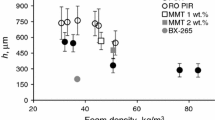Abstract
An anisotropic elastic-plastic, viscoelastic-damage model was developed to predict the multiaxial crushing behavior of polymer foams used in the core of sandwich structures. This model was based on pressure vessel experiments on Divinycell H100, whereby the post-yield response of the foam was characterized by anisotropic hardening during plastic flow, as well as damage and viscoelastic hysteresis. Post-yield properties from uniaxial compression/tension and simple shear material hysteresis experiments were used to develop three-dimensional material constitutive equations for the foam. Plastic flow was governed by the Tsai–Wu failure criterion, which was verified to accurately predict yielding of the foam in the triaxial pressure experiments. The solution methodology proved to be very effective in predicting the hysteresis response of the foam under triaxial compression, triaxial compression–tension, and triaxial compression–shear. Good agreement was found between theoretical predictions and experimental results.













Similar content being viewed by others
References
Abrate S (2008) Criteria for yielding or failure of cellular materials. J Sandw Struct Mater 10(1):5–51
Ayyagar RS, Vural M (2015) Multiaxial yield surface of transversely isotropic foams: Part I—modeling. J Mech Phys Solids 7:49–67
Caddell RM, Raghava RS, Atkins AG (1973) Yield criterion for anisotropic and pressure dependent solids such as oriented polymers. J Mater Sci 8(11):1641–1646
Chen C, Lu TJ (2000) A phenomenological framework of constitutive modelling for incompressible and compressible elasto-plastic solids. Int J Solids Struct 7(52):7769–7786
Deshpande VS, Fleck NA (2001) Multi-axial yield behavior of polymer foams. Acta Materialia 49:1859–1860
Gdoutos EE, Daniels IM, Wang K-A (2002) Failure of cellular foams under multiaxial loading. Compos Part A Appl Sci Manuf 33:163–176
Gielen AWJ (2008) A PVC-foam material model based on a thermodynamically elasto-plastic-damage framework exhibiting failure and crushing. Int J Solids Struct 45:1896–1917
Hill R (1948) A theory of the yielding and plastic flow of anisotropic metals. Proc Roy Soc Lond 193:281–297
Hoffman O (1967) The brittle strength of orthotropic materials. J Compos Mater 1(2):200–206
Hoo Fatt MS, Zhong C, Tong X (2020) On characterizing multiaxial polymer foam properties in sandwich structures. In: Lee S (ed) Advances in thick section composite and sandwich structures. Springer, Switzerland
Jun A, Diebels S (2018) Yield surfaces for solid foams: a review on experimental characterization and modeling. GAMM Mitteilungen 41:1–14
Li P, Guo YB, Shim VPW (2018) A constitutive model for transversely isotropic material with anisotropic hardening. Int J Solids Struct 138:40–49
Li P, Guo Y B, Zhou MW, Shim V PW (2019) Response of anisotropic polyurethane foam to compression at different loading angles and strain rates. Int J Impact Eng 127:154–168
Li P, Guo YB, Shim VP (2020) Micro and meso scale modelling of the response of transversely isotropic foam to impact — a structural cell-assembly approach. Int J Impact Eng 135:103404
Lubliner J (1990) Plasticity theory. Macmillan Publishing, New York, p 1990
Su B, Zhou Z, Xiao G, Wang Z, Shu X, Li Z (2017) A pressure-dependent phenomenological constitutive model for transversely isotropic foams. Int J Mech Sci 120:237–248
Tagarielli VL, Deshpande VS, Fleck NA, Chen C (2005) A constitutive model for transversely isotropic foams, and its application to the indentation of balsa wood. Int J Mech Sci 47(4–5):666–686
Tsai SW, Wu EM (1971) A general of strength for anisotropic materials. J Compos Mater 5:58–80
Zhong C (2019) Pressure chamber experiments to determine triaxial material properties of polymer foams. PhD Dissertation, The University of Akron
Acknowledgements
This research was supported under ONR Grant N00014-16-1-2840. The authors would like to thank Dr. Yapa D. S. Rajapakse, Solid Mechanics Program Manager at the Office of Naval Research, for making this work possible.
Author information
Authors and Affiliations
Corresponding author
Ethics declarations
Conflict of interest
On behalf of all authors, the corresponding author states that there is no conflict of interest.
Additional information
Publisher's Note
Springer Nature remains neutral with regard to jurisdictional claims in published maps and institutional affiliations.
Appendices
Appendix A
1.1 Damage stiffness of equilibrium spring
For the equilibrium spring, the actual damage cases, \({\varvec{\upsigma}}_{eq}\) and \({\varvec{\upvarepsilon}}_{e}\), are the stress and elastic strain acting at a material point:
Assuming there is no damage, the corresponding stress \({\tilde{\mathbf{\sigma }}}_{eq}\) and strain \({\tilde{\mathbf{\varepsilon }}}_{e}\) are called effective stress and effective elastic strain, respectively:
They are defined based on equality of the elastic strain energy in the equivalent spring, given as
Substituting Eqs. (54) and (55) into Eq. (56) gives
The damage tensor \({\mathbf{D}}_{eq}\) is defined to build the connection between \({\varvec{\upsigma}}_{eq}\) and \({\tilde{\mathbf{\sigma }}}_{eq}\) as follows:
Since \({\varvec{\upsigma}}_{eq}\) and \({\tilde{\mathbf{\sigma }}}_{eq}\) should be the same stress states, \({\mathbf{D}}_{eq}\) has to be a diagonal matrix given as
Substituting Eq. (58) into Eq. (57), we have
Equation (57) can be simplified as
Considering uniaxial loading case in 11-direction, we have
and
where \(\bar{E}_{11}\) is the actual damaged modulus measured from the test.
Substituting Eqs. (62) and (63) into Eq. (56) and considering all the other stresses as zero, we get
From Eqs. (58) and (59), the damage coefficient \(D_{eq11}\) is obtained as
Similarly, all the other damage coefficients inside the \({\mathbf{D}}_{eq}\) matrix can be obtained from the uniaxial and simple shear tests and the damage tensor finally takes the form:
Appendix B
2.1 Post-yield plasticity and viscoelastic-damage functions
The normalized flow stress and viscoelastic-damage parameters are plotted in Figs. 14, 15, 16 and 17.
Rights and permissions
About this article
Cite this article
Tong, X., Hoo Fatt, M.S., Zhong, C. et al. Predicting anisotropic crushable polymer foam behavior in sandwich structures. Multiscale and Multidiscip. Model. Exp. and Des. 3, 245–264 (2020). https://doi.org/10.1007/s41939-020-00071-5
Received:
Accepted:
Published:
Issue Date:
DOI: https://doi.org/10.1007/s41939-020-00071-5








